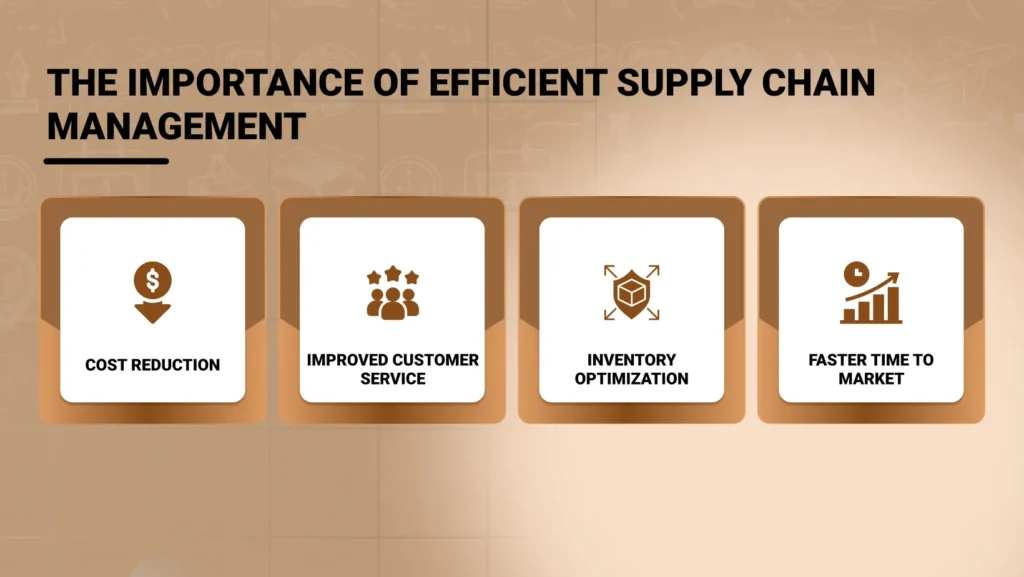The backbone of economic expansion is supply chain management (SCM). It bridges the gap between businesses and consumers. Supply chain management handles the transformation of raw materials into end products. The supply chain is essential. Supply chain management involves suppliers connected through centralized business processes. Additionally, the chain is managed with suppliers tied by key business methods. Every supplier is a link. Furthermore, they move the products from raw material handlers to makers to sellers.
Managing a supply chain in business means makers can create bulk goods in line with market needs. This practice aids sellers in slashing surplus stock and cutting costs. Great sales and promotional results hinge on managing supply chains well. This aids in securing the precise item is in stock and ready at the needed location and time.
The PwC Global Supply Chain Survey of 2022 revealed a consensus. Almost everyone, 97%, confirmed supply chains are key to business. Furthermore, 94% saw it as a competitive edge. Another survey, this one by the Council of Supply Chain Management Professionals, told its analysis. It pointed out that businesses with good supply chain abilities are better off. They gains up to 16% more profit and 15% more market value compared to others.
In this article, we’ll explore why supply chain management (SCM) is key to the success of all businesses, the importance of efficient supply chain management, how supply chain management impacts business success, Strategies for improving supply chain management, Risks of poor supply chain management, and the list of technologies used in the supply chain.
The importance of efficient supply chain management
The following are the importance of efficient supply chain management and how it helps businesses to make profit.
Cost Reduction:
Making supply chain management smoother can help slash expenses big time. This comes from reducing waste, improving transportation paths, and using large-scale operations. For instance, a study from Gartner suggests that businesses could cut down supply chain expenses by a whopping 15% with a well-run supply chain management.
Improved Customer Service:
Handling supply chains right means goods and services get where they need to on time. This makes customers happy and keeps them coming back. Firms that rock at this typically give better customer service than the other guys.
Inventory Optimization:
Good supply chain management aids businesses in maintaining just-right inventory amounts. Additionally, this helps in lowering the chances of running out of stock or having too much. As a result, storage expenses decrease, and profits increase.
Faster Time to Market:
When supply chains work smoothly, companies can get new items out quicker. This efficiency gives businesses an advantage. It helps grab and keep their spot in the market.
Risk Mitigation:
Through supply chain management, companies find and lessen possible dangers. Consequently, these might include waste along the supply chain, problems with product quality, or breaking rules set by authorities. All while shaping their operations and guarding their good name.
How supply chain management impacts business success
The supply chain industry is a billion-dollar industry, and developing talent in this sector is essential to ensuring business continued success across a wide range of industries. However, by investing in supply chain management talent, companies can improve their cash flow, and reduce their revenue rates, making employees and customers happy and satisfied.
The following is the impact of supply chain management on business success, these are:
Cost Efficiency and Cost Reduction:
With smarter processes, cutting out waste, and bigger scale, companies can save a lot of cash. This is shown through their supply chain. It leads to better profits and a strong bond with their rivals.
Competitive Advantage:
A streamlined supply chain can offer businesses an advantage. However, this comes from quicker product launches, superior client service, and enhanced availability.
Customer Satisfaction:
Getting goods on time, having products in stock, and top service help make customers happy. This boosts their loyalty, and they keep coming back.
Risk Management:
A solid supply chain organization lets companies spot, evaluate, and lessen possible problems. It also shields their firm and good name from disturbances, quality snags, and rules adherence, among others.
Risks of poor supply chain management:
Failure to implement effective supply chain management can lead to serious risks that affect their operations, profitability and reputation. Some of the major risks associated with poor supply chain management are:
Increased Costs:
Inefficiencies, excessive inventories, inefficiencies in transportation, and operational disruptions can lead to higher costs throughout the supply chain, undermining profitability and competitiveness for example, products that have incorrect storage can result in excessive vehicle costs or inventory, resulting in lost sales opportunities.
Disruption of Operations:
Supply chain disruptions, such as supplier issues, transportation delays, natural disasters, or cyber-attacks can significantly affect business operations and result in lost revenue, and missed deadlines, and customer satisfaction results Failure to plan for contingencies and risk management strategies can exacerbate the impact of such problems.
Decreased Customer Satisfaction:
Delivery delays, inventory holds, or quality issues resulting from supply chain failures can damage customer satisfaction and loyalty, resulting in lost business and long-term reputational damage.
Inventory Issues:
Poor inventory management can result in excess inventory costs, causing inventory costs to become obsolete, or inventory to build up, resulting in sales missed opportunities and customer disappointment have resulted Imbalances in inventory levels can also disrupt production schedules and lead to inefficient use of resources.
Strategies for improving supply chain management
The following are strategies for improving supply chain management:
Process Optimization:
It’s important to check and fine-tune supply chain processes. This helps us spot and remove any hiccups, cut back on waste, and make things better. Start by plotting the full supply chain, finding stumbling blocks, any repeats, or stuff that doesn’t add value.
Then use lean principles to make operations smooth. Methods like value stream mapping, process reengineering, and ongoing betterment strategies come in handy.
Inventory Management:
Effective inventory management strategies are key to maintaining appropriate stock levels and reducing storage costs. Techniques such as just-in-time (JIT) management, vendor-managed inventory (VMI), or demand-led tactics help businesses find the balance between stock level and consumer requirement. Plus, leveraging technology like RFID, barcodes, and automatic inventory monitoring systems enhances the accuracy and clarity of stock visibility.
Supplier Relationship Management:
Poor relationships with suppliers might cause big issues and extra costs. These problems can cut down your earnings. In a business where there’s no supplier, there’s no item or items to sell. However, affordable, good-quality products help your company do well.
Consequently, good suppliers who can give great products for less money will make your customers happy. Their continuous support will help your company earn more money and make more profit.
Technology Integration:
Building good team bonds with suppliers is key to a dependable and quick supply chain. It’s all about looking ahead, keeping in touch regularly, watching their work progress, and always trying to do better.
Consequently, checking that suppliers meet our standards, setting targets and key measures of success (KPIs), and having honest talks with transparency help firms match suppliers to their aims and quality bars.
Demand Planning and Forecasting:
To remain highly profitable, businesses must accurately predict inventory demand and supplier performance. Demand and supply forecasts are essential to keep inventories down and prices stable.
For those who manage supply chains, it’s key to grasp deeply how different elements might influence the need for what they offer. Things like the economic climate, competitor activity, and customer likes are key to consider.
Forecasting demand correctly means knowing how the supply chain’s unique parts gel. When changes in what customers want are predicted and production tweaked to match, avoiding low or extra inventory, money is saved, and earnings aren’t hurt.
Risk Management:
Spotting and dealing with possible dangers in the supply chain is key for keeping businesses steady and robust. However, it needs checking for risks, making backup plans, and using ways to manage risk like having different suppliers, creating duplicates, or using protections like insurance or contracts. Also, staying alert and having early detection systems can assist businesses to notice and act on possible bumps in the road more effectively.
Continuous Improvement:
Improving supply chain management is not a one-off task. Businesses need to keep watching their supply chain’s results––keeping tabs on important benchmarks.
They also need to keep up with shifts in the market. Being able to adjust when surprises like natural disasters or shortages happen shows a well-made supply chain. Frequent check-ups, input from others, and a culture that keeps changing are key in this shift.
The role of technology in supply chain management
Technology plays an important role in supply chain management. The following is the list of technologies used to enhance the features of the supply chain and upgrade the work of inventory or supply chain management.
Automation and Robotics:
Robots assist in the supply chain, handling materials or assembling products quicker and more effectively than people. As we apply AI and IoT, these robots will grow in capability. Manufacturing automation goes beyond just substituting human work with machines. It involves software and fresh technologies that fine-tune and speed up processes.
For example, AI can spot mistakes in products, tools, or methods swiftly and come up with solutions instantly, instead of discovering the mishap after production, thus saving the company valuable resources.
Supply Chain Management Software (e.g., ERP Systems):
ERP systems act like the main station, linking data from varied departments. It helps them work together better, boosting chat and teamwork. It links everything in the supply chain. The key task is managing stock. Businesses balance the number of goods, cut down extra stock, and limit storage costs. The ERP systems also predict demand better, helping businesses decide wisely and avoid little or too much stock.
Internet of Things (IoT):
All over the world, supply chains and logistic networks are facing new trials and shifts. They’re leaning more and more on Industry 4.0 tech for help, with IoT technology. IoT technology is changing the game for supply chain management (SCM).
Companies that think ahead use IoT devices to turn tricky supply chains into fully networked systems. Moreover, for those in supply chain management, keeping tabs & supervising are key goals of using IoT. Additionally, this tech lets warehouse and fleet managers stay on top of their freight and stock.
Blockchain Technology:
Blockchain technology makes sure transactions are confirmed, logged, and made safe. Furthermore, they swap out slow, manual tasks and boost trackability. It works with bitcoin or digital currency dealings, blockchains are moving into other work areas, like making goods, to handle supply chain trouble, like tracking the owners of goods.
Moreover, this web-based tech acts like an independent, digital log to note transactions and send them to other users across the globe in the network. Additionally, blockchains keep these transactions safe with encryption, promising top-notch security and rapid transmissions.
Artificial Intelligence (AI) and Machine Learning:
AI boosts decision-making. It aids in lowering empty cargo hauls and arranging staff tools. Businesses that use AI are outperforming those that aren’t up to speed with tech. Consequently, this unique software mimics human thinking and actions through algorithms. These can change over time, learning from past work. Simply put, it learns and adapts to better its methods, using past failures and wins as lessons.
Conclusion
In conclusion, supply chain applications are changing the aspect of supply chain management. It brings real-time visibility to your operations and allows you to communicate with your stakeholders.
However, for a supply chain management company, two of the most important goals are to get goods to the right place on time and to receive real-time alerts. With the help of solutions analysts, Solutions Analysts can help many companies reach these goals and provide better services.
Therefore, by creating cross-platform apps, our company gives users access to a variety of features and capabilities that make operations more efficient, improve connectivity, and enhance user experience.
Partnering with one of the world’s leading cross-platform app development services companies for access to innovative solutions and to build a relationship based on trust and common goals.
FAQs
What is the role of supply chain management in risk mitigation and business continuity?
Strategies in managing supply chains assist companies in spotting, examining, and reducing possible threats like interruptions in supply, problems with quality, or breaks in compliance. These strategies shield the business’s functioning and name, guaranteeing an uninterrupted workflow.
How can supply chain management provide a competitive advantage to businesses?
A quick, reactive supply chain leads to quicker market entry. It supports better service for customers, boosts product access, and cuts costs. This gives businesses a leg-up over their competition.
What are the risks associated with poor supply chain management?
Failure to implement effective supply chain management can lead to serious risks that affect their operations, profitability and reputation. Some risks associated with poor supply chain management are increased cost, disruption of operations, decreased customer satisfaction, inventory issues, quality control problems, and more.
How does supply chain management support sustainability and corporate social responsibility initiatives?
Managing a supply chain can include green steps. For instance, lowering your carbon impact, cutting down on waste, choosing ethical sources, and backing social efforts. This can boost a company’s image, satisfying those invested in its success.
What are the key strategies for improving supply chain management processes?
Strategic approaches incorporate refining procedures, handling stock, managing supplier relations, integrating tech, planning and predicting demand, mitigating risks, constant betterment, nurturing talent, promoting sustainable initiatives, and enhancing cooperation and communication.










